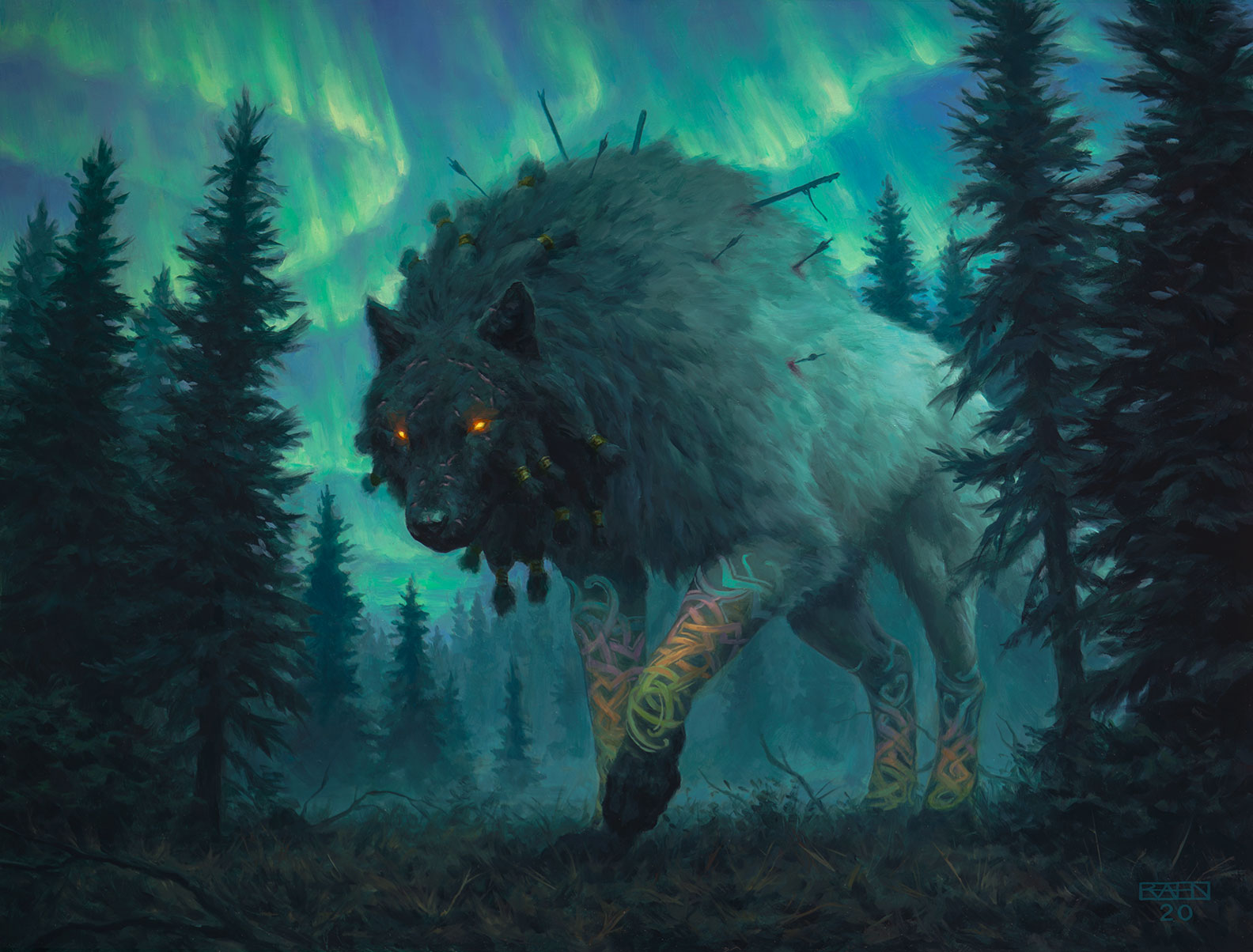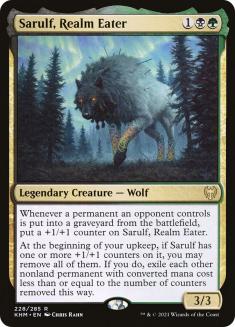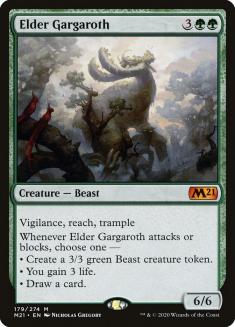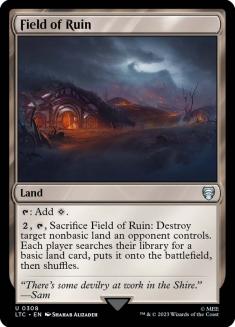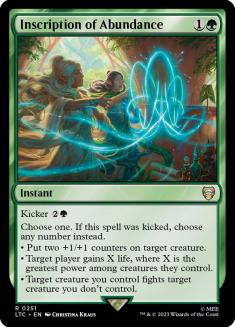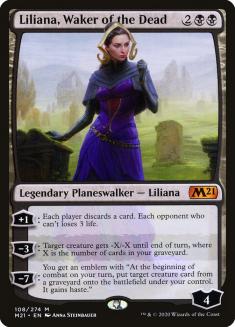Printing a creature that can blow up everything else on the battlefield can be risky. Such a card runs the risk of making the game all about whether or not it lives, at least depending on how easy it is to activate. Thankfully, Sarulf, Realm Eater is in the ideal position of being interesting and not completely broken.
So, is Sarulf, Realm Eater a control finisher, the perfect midrange card, or just a really big threat with upside?
Honestly, maybe all three.
In order to figure that out, we need to think about how to best utilize the card and how often we’ll be using its ability. What can we expect from Sarulf?
For starters, getting cards into your opponent’s graveyard from the battlefield is more of a tall order than you probably think. How many nonland permanents will your opponent put on the battlefield per game? How many will you be able to remove?
Five? Ten? Resources tend to naturally trade as a game goes on, but directly from the battlefield? That’s not a guarantee. What if your opponent is playing a control deck?
Of course, the flip side to that is your opponent playing a low-to-the-ground aggro deck or a deck full of tokens, in which case Sarulf will likely dominate.
There are some ways to help Sarulf. In theory, you could give your opponent permanents and destroy them, although maybe that’s not a thing you can do in Standard. Any Fabled Passage (or Treasure token!) from your opponent is going to help you out. In a two-color deck, you can also use Field of Ruin to great effect.
Thankfully, if you can get one solid use out of it once, it’s possible that you might be so far ahead that the threat of the second will all but lock it up. In the meantime, you’ll be pressuring your opponent.
If you’re relying on Sarulf as a sweeper, you’ll probably be disappointed due to how poorly it does that job as a topdeck.
Another one of the downsides is you can’t necessarily control how many counters you remove. For example, if your opponent only has three-mana cards, and you have a powerful four-drop and four +1/+1 counters on Sarulf, you’re going to have to blow up your own stuff if you want to get your opponent’s.
The fact that Sarulf sticks around is the saving grace, plus you can also build around it. For example, you can use it as a way to blow up your own permanents with downsides, like Treacherous Blessing. That’s not a requisite for making Sarulf playable but it’s another angle to take.
It’s legendary but that’s not necessarily a bad thing. Your opponent must deal with it at some point.
As a threat, it’s immune to Stomp, unkicked Bloodchief’s Thirst, and most Heartless Acts. That’s very solid for a three-drop that doesn’t immediately impact the battlefield. Even if we’re not consistently blowing up the world, having some built-in resiliency might be enough to make Sarulf playable.
Creatures (14)
Planeswalkers (6)
Lands (24)
Spells (16)

This is the obvious shell in which to try Sarulf and its Pernicious Deed-like ability. Classic versions of The Rock always appreciated the fast clock from things like Treetop Village and Ravenous Baloths, so Sarulf is right at home. The best-case scenario for a deck like this will involve playing Sarulf, growing it, and threatening the reset.
We normally treat Elder Gargaroth like a Baneslayer Angel, which is something that will often live in your sideboard for aggro matchups. As time has gone on, it’s become more and more obvious that it’s a perfectly fine maindeck card. You’d think that it’s just a big, dumb creature that dies to removal or gets countered easily, but that’s not usually how the games play out.
Elder Gargaroth is basically the perfect companion for Sarulf. It’s expensive, which means it’s difficult to kill with your own Sarulf, and won’t result in a substantial tempo loss if you’re able to bait out your opponent’s removal.
Field of Ruin is incredible with Sarulf. You’ll likely be struggling to grow Sarulf over the course of the game but Field of Ruin could make that trivial. It has a low opportunity cost, almost everyone has targets, and it can allow Sarulf to get out of hand quickly.
Unfortunately, Heartless Act doesn’t work well with Chevill, Bane of Monsters, so we can’t realistically play it. Bloodchief’s Thirst, Eliminate, and Elspeth’s Nightmare all target smaller threats, so Murderous Rider looks like a good option. If our goal is to ensure Sarulf grows, we may need more cards like Murderous Rider that are less restrictive. Maybe that means incorporating Heartless Act and removing Chevill, but Chevill seems powerful here.
Inscription of Abundance is a solid card that feels at home here and perhaps I’m still undervaluing it. It can jump-start Sarulf, kill large threats, or help you stabilize.
If we’re doing the whole attrition-based midrange plan, Liliana, Waker of the Dead is quite powerful. You can trade your potentially dead removal spells for your opponent’s resources, which is a huge upside in a deck that will likely have dead cards. That said, it does potentially lower the amount of cards your opponent can commit to the battlefield, which makes growing Sarulf more difficult. If you have both, you’re probably in fine shape though.
Treacherous Blessing could certainly be a maindeck card. We could use the card advantage but I’m skeptical of our ability to remove it whenever we want. If abusing Treacherous Blessing were easier, I’d be on board.
Turntimber Symbiosis isn’t something you’re happy to cast, especially with the low creature count, but it has a low opportunity cost. Getting to front-load +1/+1 counters on Sarulf is pretty nice though.
The Great Henge is something I’d love to utilize, but it looks difficult to play enough large creatures to enable Henge while also having removal for our opponent’s cards. Maybe creatures are good enough and I don’t need as much spot removal as I think I do since we can trade in combat.
Maybe something closer to Mono-Green Aggro could utilize Sarulf alongside Swarm Shambler. Perhaps a build that’s more focused on +1/+1 counters could work. Conclave Mentor and Oran-Rief Ooze are the start of a solid archetype and Inscription of Abundance is underplayed.
Creatures (4)
Planeswalkers (1)
Lands (26)
Spells (29)

I did my best but it’s genuinely funny how much anti-synergy is in this deck.
Extinction Event and Ugin, the Spirit Dragon both exile. Counterspells prevent permanents from hitting the battlefield to begin with. Ugin can Ghostfire things and you’re probably not worried about how many counters your Wolf has when you also have an Ugin, so I suppose it isn’t as egregious.
Ideally, you’d be able to move more toward Drown in the Loch as a counterspell that can also get a counter on Sarulf, but it’s not easy to enable without the help from the various Rogues.
Running three colors means the loss of Field of Ruin, which honestly seems like one of the easiest ways to power up Sarulf. Shark Typhoon makes a token, which you can trade away in combat, but that will never live through a Sarulf activation.
Mazemind Tome gives us the gas to keep Sarulf growing, although it has poor synergy with Sarulf itself. That probably means you’ll have to scry more aggressively with Tome than you otherwise would. I tend to get three cards and a scry from Tome (at least if I’m not choked on mana) but I also use it more conservatively than others, so maybe that only applies to me.
Basically everything about this deck is pointing toward Sarulf not being viable in a true control deck, but I’m fine with that. We could potentially get some help from Kaldheim or future sets but I’m not seeing it. I am genuinely excited to try out the Golgari build though.
You’d think that if the card were meant to be a major player in Standard, it would have been a mythic rare. It has a lot of words and a unique effect, and a rider like deathtouch could have gotten it there. It’s a minor point but one that leads me to believe Sarulf is meant to be a role-player and not necessarily an all-star.
Sarulf has a unique effect in a color combination that can greatly benefit from it. The main reason I have hope for Sarulf is because of stats. It’s a (potentially) large creature with upside and that shouldn’t be ignored.

